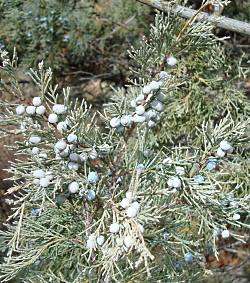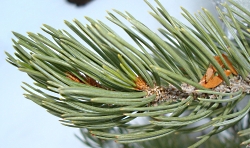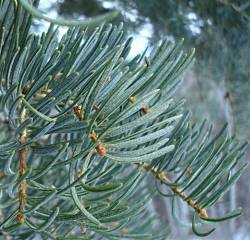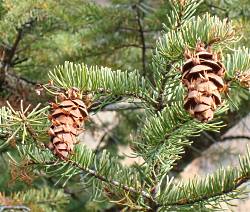
Copyright © 2009 Linda Kervin
 Two-needle Pinion Pine
Two-needle Pinion Pine
Copyright © 2009 Linda Kervin
 Norway Spruce Cones
Norway Spruce Cones
Copyright © 2009 Linda Kervin
Now that the leaves have fallen from the deciduous trees, we can fully appreciate Utah’s evergreen trees. Conifers are trees that bear their seeds in cones instead of producing flowers and fruits. Utah has five kinds of conifers; all with stiff, needle-like leaves that remain green throughout the winter. Traits of their needles and cones allow you to distinguish between our different types of conifers. Cones can be found still attached or scattered on the ground.
I will start with the junipers. These conifers have scaly, slightly fleshly leaves. Juniper seeds are embedded in a cone that resembles a green berry. The cones are round and densely fleshy. Junipers are widely adaptable here, from arid foothills to rocky alpine slopes.
Our pines collectively span this same elevation range. They are the only conifers that have cylindrical needles bundled in clusters of 2 to 5. The one exception to this is Single Leaf Pinon, which as you might guess has single, round needles. The count of pine needles is often diagnostic of their species. Pinons mix with junipers at low elevations; their oily, wingless seeds are the edible pinon nut. Bristlecone pines, found in southern Utah, can live for over 1000 years.
Spruces are conifers that many recognize from their own yards. The spruce needle leaves a peg on the stem when it drops, which gives their twigs a rough, nubbly surface. Spruces grow in a classic pyramidal shape.
Another montane group is the true firs. Their flat needle attaches smoothly to the twig. True firs have uniquely upright cones that gradually disintegrate without dropping to the ground. Crushed fir needles are wonderfully fragrant, redolent of tangerines or grapefruit. Perhaps that is why true firs are a favorite Christmas tree.
Douglas fir, despite its common name, is in a different genus than the true firs. Its cones are distinctive; having long, three-pointed, papery bracts that project out from amid the cone’s scales. Douglas fir is one of the west’s most valuable timber tress. Like the spruces and firs, it is a montane species.
Conifer trees are a great resource for Utah wildlife, providing food and shelter, especially in the icy cold of winter.
This is Linda Kervin for Bridgerland Audubon Society.
Credits:
Pictures: Copyright © 2009 Linda Kervin
Text: Linda Kervin and Jim Cane
Additional Reading:
Sibley, David Allen. 2009. The Sibley Guide to Trees. New York: Alfred A. Knopf.
Johnson, Carl M. 1991. Common Native Trees of Utah. Utah State University Extension Service. Logan, UT. 109 p
Kuhns, Michael R., Utah Forest Facts, Conifers for Utah, https://extension.usu.edu/forestry/Reading/Assets/PDFDocs/NR_FF/NRFF015.pdf, USU Extension


